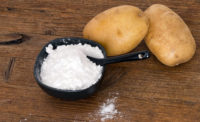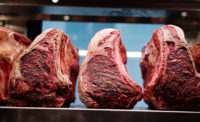Guest Commentary | Dr. Phil Bass
Lamb meets demand for flavor intensity

The other day I saw a package of habanero-flavored Doritos (bear with me, this is not a column about snack foods), which reminded me of a movement I’ve observed in the flavor world around ratcheting up flavor intensity (granted, I don’t have empirical evidence to back up calling this a movement, but just look at the shelves!). Consumers have shown a real desire to “up the ante” of sorts on robustness and strength of essences in food. With sriracha-flavored this and smoky-flavored that, there seems to be a race to see who can create the most intense flavors.
Want another example? Look at the flood of intensely hopped India pale ales (IPAs) in the beer retail industry — not a flavor profile for the most sensitive taste buds, yet there seems to be a near limitless supply of IPAs by every brewery out there. And even within the IPA world there are extreme levels that could make the toughest beer barons squint and cry uncle (such as Palate Wrecker by Green Flash Brewing Company, among others). It’s apparent to me that food connoisseurs desire to push the limitations of their palates.
This long-winded lead brings me to the meat industry (finally, you say?). There has been a tremendous pull-through demand for beef in the last few years. There are many variables that have helped the uptick in per-capita beef consumption in the United States, but I believe one of those has to do with the preceding paragraph; beef satisfies with flavor and familiarity like no other. This concept has been drawn out by the eye-popping growth of dry-aged beef products served in restaurants and the products that are out there for home chefs to try. As I’ve mentioned before, dry-aged beef offers a flavor that is more intense than traditionally aged beef. And this is where our friend, the humble sheep, may have an opportunity to ride the wave of flavorful red meat. With this uptick in demand for intense flavors, I think the time is right for lamb to shine in the United States.
I grew up eating lamb probably as often as I did beef. Mom would often use a touch of rosemary and a bit of lemon juice to complement the flavor of the lamb we raised on the north coast of California. At Colorado State University, I was introduced to Colorado grain-finished lamb. What I came to learn was there were certainly the possibility of different products coming from the same species, many differences depending on the finishing of those animals. Both were delicious but very different in flavor.
Flavor research from my alma mater has revealed in recent years a more intense flavor from lamb than most other domesticated livestock species. That flavor — although stronger than beef, pork and chicken — is still rather desirable. This is why I have begun to consider the position that lamb and sheep meat is in. It seems it is that naturally flavored steakable item that could readily satisfy the more adventurous palate on a regular basis. Lamb also lends itself to a multitude of cultural cuisines. The flavor of lamb is of course traditional in recipes of northern Europe, virtually all of the Mediterranean, Middle East, Africa and Asia, and just about any island nation. Lamb is accepted nearly everywhere (those in southeastern South Dakota know of a delicacy called “chislic” and, from what I’ve been told, must be made of lamb to be culinarily correct). Lamb can be produced under Halal, Kosher and traditional North American means to serve a variety of customers. It’s a versatile and tasty protein solution.
Lamb also comes in a variety of cuts that can help a business differentiate itself. It’s time for the greater culinary community to consider what we in the meat business call “end meats” and “thin meats,” going beyond the traditional rack of lamb or loin chops, which are of rather high value. Although the lamb leg is the more affordable of the traditional lamb cuts, it can still be a higher-priced item compared to the opposite end of the carcass (i.e., the shoulder). A recent U.S. Department of Agriculture (USDA) summary of retail cuts shows bone-in shoulder chops about 80 percent of the cost of a boneless leg of lamb. I absolutely love lamb shoulder chops for their character, texture and flavor. The lamb breast is another great value item and about half the price of a leg of lamb. The lamb breast allows for a stuffed application that helps infuse the robust flavor of the lamb while lending to a plate presentation that is also a feast for the eyes.
Calling Idaho my adopted home, I still have an unrelenting passion for beef cattle and the succulent steaks they produce. I also realize sheep are raised in large quantities in this great state as well — a fabulous flock might be found just down the road from a herd of happy cows. It’s time to get the word out about the dining benefits of lamb and how it can easily fit within a flavorful foodie feast. Let’s see what we can do to deliver a great-tasting animal protein to a hungry meat-eating populace while also benefiting the hard-working sheep producers in this great country.
Lamb; it’s not just for Easter anymore. NP
Looking for a reprint of this article?
From high-res PDFs to custom plaques, order your copy today!






